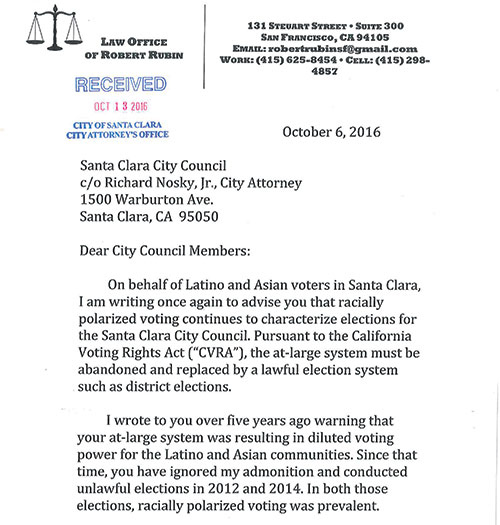
Santa Clara’s at-large by-seat election system faces the serious threat of a costly California Voting Rights Act (CVRA) lawsuit, but the current Santa Clara City Council appears to be keeping that information from citizens and off the council agenda.
On Oct. 6 civil rights attorney Robert Rubin sent a letter to the City of Santa Clara – the second in five years – threatening a California Voting Rights Act (CVRA) lawsuit in no uncertain terms. The WEEKLY received a copy of the letter through a public records act request.
“It is time to cease your illegal actions and come into compliance with the CVRA,” Rubin wrote. “If you do not promptly do so, you will be sued.”
The date stamp shows the letter was received on Oct. 13. As of press time, the City Council has yet to put the threatened litigation on an agenda. The Council had a special meeting Tuesday afternoon, but this wasn’t on the agenda. The Council isn’t scheduled to meet until after the election, on Nov. 15, more than 30 days from the date the letter was received.
The Council replied to the WEEKLY’s request for comment, “The City is in receipt of Mr. Rubin’s letter but has very limited options at this late juncture before the election. The City will fully vet the legal issues presented by Mr. Rubin immediately after the election to decide what appropriate actions should be taken, if any.”
The CVRA was passed in 2002 and goes beyond the federal Voting Rights Act by eliminating the requirement to identify specific geographic areas where minority populations are concentrated enough to elect representative candidates, but cannot because their votes are diluted by at-large systems.
A 2011 demographic study found that Santa Clara is 39 percent Asian-American, 36 percent European-American and 19 percent Hispanic. It also found that Santa Clara’s residential neighborhoods reflect those proportions. In other words, Santa Clara is an integrated city. This year’s Council candidates reflect that: five are Asian-Americans, four are immigrants and three are under 30.
The current makeup of the Council is all white and all are over 40, with all but one over 50.
Rubin threatened the city in 2011 with a similar lawsuit. Since then, the city has appointed two charter review committees, but has done nothing toward fostering a more representative Council. Rubin sent the current letter, he said, instead of filing a lawsuit because “it was better to give the city a chance to make the [election method] change on its own and convene a charter review.”
The Council tabled the 2011 committee’s recommendation to change to a fully at-large system. The first recommendation was a ranked choice or instant runoff system like San Francisco’s, but Santa Clara County systems couldn’t handle such an election system – and still can’t.
The 2016 committee was appointed in late 2015 following a sudden show of anxiety on the part of Council Members that the City might be sued under the CVRA – although there was no actual threat or even an indication of one at that time.
The stated purpose for appointing the committee was to study election methods. But the committee dismissed that question from its deliberations; preferring instead to spend half its time discussing the Council and the rest of the time brainstorming what, other than the election system, individual members would like to change in the City Charter. Four of those committee members are now running for City Council.
The Council, for its part, was on the same wavelength about the committee’s agenda and never said anything about the original mission, or even gave any indication that there had ever been a change in mission.
In its final report, the committee recommended the Council appoint another committee if they wanted to study election methods.
How does Rubin interpret this history? “It says they’re not prepared to do it on their own,” he said.
The Costly Consequences of CVRA Lawsuits
The consequences of CVRA lawsuits are serious. Once one is brought, by law the plaintiff’s legal bills must be paid by the defendant, regardless of whether or not the case goes to court. The costs and judgments can run into the millions. That’s in addition to the cost of changing election systems and, possibly, being forced to hold another election.
Only one city, Whittier, has won a CVRA lawsuit. But that’s only because Whittier changed its election system. The city still had to pay the plaintiffs’ attorneys almost $1 million, in addition to its own legal bills.
Modesto’s challenge to a 2006 CVRA lawsuit went all the way to the U.S. Supreme Court, which declined to hear it, and ended up costing Modesto taxpayers almost $5 million.
Last year, Palmdale settled a years-long CVRA lawsuit with three civil rights groups for $4.5 million plus interest. Some estimate the full cost to taxpayers will top $7 million. Palmdale’s population is three-fourths minority, but in the past minorities “rarely” won seats on its City Council, according to a May 2015 Los Angeles Times story.
But the financial hit wasn’t the worst of it. In Dec. 2013, the judge who had previously found Palmdale in violation of the CVRA, refused to certify the city council election. He ordered the city to establish election districts drawn by the court, and to hold a special election in June 2014.
City Council Agenda
There are four ways something can be put on a City Council agenda: by the Mayor, by a Council Member’s request, by a Council Committee as part of its minutes and by a member of the public. The City Manager compiles the agenda.





